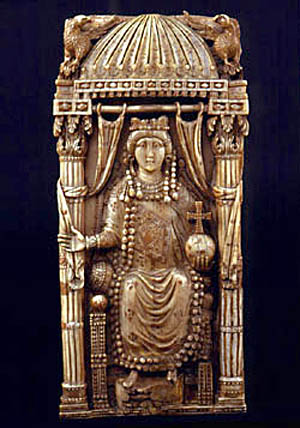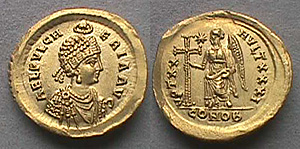 |
The Saint of the Day
St. Pulcheria – September 10
Prof. Plinio Corrêa de Oliveira
Biographical selection:

5th century Byzantine Empress,
probably St. Pulcheria
|
“Thanks to you, the scandals stimulated by the evil spirit were suppressed. Thanks to your efforts, the whole earth today is united in the confession of the same Faith.”
With these words, Pope St. Leo the Great paid tribute to Empress Pulcheria (399-453), grand-daughter of Theodosius. She was baptized by St. John Chrysostom in Constantinople and while still very young, she made a vow of virginity along with her two younger sisters.
Six years after her father, Arcadius, died, the Senate proclaimed her Augusta (empress), and named her regent of her younger brother Theodosius II. Pulcheria was 15 years old when she assumed the full responsibility of government. It is rare in History to find so much prudence joined with such great precocity.
At age 20, Theodosius married Athenais, daughter of a pagan philosopher of Athens. His wife, who received the name Eudoxia when she was baptized, sought to weaken Pulcheria’s influence over the Emperor. Eudoxia ended by persecuting her sister-in-law and favoring the heresy of Nestorius, while St. Pulcheria supported St. Cyril of Alexandria against the heretic. Pulcheria was removed from power and withdrew from the court.
In 441 Eudoxia was exiled because of her infidelity to the Emperor, and Pulcheria returned. Theodosius was supporting the heresy of the monk Eutyches, but Pulcheria convinced him to withdraw it and follow St. Leo the Great.
In 450 Theodosius died. Pulcheria was again proclaimed Empress. One year later the Council of Chalcedon (451) – she assisted at its third session - condemned Monophysism, the heresy of Eutyches. In a letter to the Empress Pulcheria, St. Leo credited her with overcoming the heresies of Nestorius and Euthyches.
On her return from exile, she found the Empire threatened by Attila. She agreed to marry General Marcian to maintain the stability of the Empire on the condition that he respect her vow of virginity. Together they governed the Empire. Marcian persecuted the Nestorians and followers of Eutyches, recalled the Catholic Bishops who had been exiled by Theodosius, and kept Attila outside the boundaries of the Empire. St. Pulcheria died in 453 at age 54.
Comments of Prof. Plinio:
It is a most beautiful life! A life full of lessons that deserve commentaries.

5th century Byzantine coins
imprinted with the profile of Empress Pulcheria
|
First, you can see the very important role of elites in giving good example in the customs and protecting the Catholic Religion. In his eulogy of St. Pulcheria, St. Leo the Great gave her the credit for the bad customs being suppressed and the whole earth having the same unity of Faith. This happened because a certain woman who consecrated herself to God was raised to the imperial throne, held the reins of the government, and used this power and influence to favor a Saint who was a Pope, St. Leo, and the Patriarch of Alexandria, St. Cyril.
Above all, the Catholic Religion must have holy priests, Bishops, and Popes. But often this is not enough. It is also necessary to have saints in the principal posts of the civil order. The life of St. Pulcheria teaches us that the laypeople also have an important role to play in building Christian Civilization and defending the Church. The clergy, even with saints as Pope and Bishops, was not able by itself to extirpate the heresies of Nestorianism and Monophysism.
Second, St. Pulcheria’s first care was for the service of God. She consecrated herself as a virgin; she was the regent of her brother; she fought against the bad influence of her sister-in-law; she was exiled but did not abandon the good cause; she returned and helped it conquer. Her only concern was to make the cause of God victorious.
Third, there is one point that is not clear in this admirable life. Given her influence over her brother, why did she allow him to marry Eudoxia? The latter was the daughter of a pagan, and eventually caused an enormous problem for the cause of God. The selection does not mention who arranged that marriage. Would it have been a concession on the part of St. Pulcheria? It is possible. Then, she would not have been a saint yet. Was there a good reason for that marriage? Perhaps. At any rate, it was made with a high price, since St. Pulcheria was exiled because of it and the heresiarchs Nestorius and Euthyches were protected by Eudoxia. Once again, it follows the same principle, with a good Empress, everything goes well; with a bad Empress, everything worsens.
Fourth, it is interesting to notice what happened with Attila. When he came to the West, he did not go straight to the Western Roman Empire. First, he tried to invade the Eastern Roman Empire. He was defeated there, and then decided to enter Western Europe where he caused the devastation we know. We can see the role of the Holy Empress who through her prayer and action decisively kept those terrible enemies out of the Empire.
What should we ask of St. Pulcheria? We should ask her for the grace to understand and make understood with renewed ardor our role as laymen in temporal society following the plan of Divine Providence. That is, to serve God and Holy Mother Church living in the temporal order and transforming it into a true Christendom.


  | | Prof. Plinio Corrêa de Oliveira | |
The Saint of the Day features highlights from the lives of saints based on comments made by the late Prof. Plinio Corrêa de Oliveira. Following the example of St. John Bosco who used to make similar talks for the boys of his College, each evening it was Prof. Plinio’s custom to make a short commentary on the lives of the next day’s saint in a meeting for youth in order to encourage them in the practice of virtue and love for the Catholic Church. TIA thought that its readers could profit from these valuable commentaries.
The texts of both the biographical data and the comments come from personal notes taken by Atila S. Guimarães from 1964 to 1995. Given the fact that the source is a personal notebook, it is possible that at times the biographic notes transcribed here will not rigorously follow the original text read by Prof. Plinio. The commentaries have also been adapted and translated for TIA’s site.
|
Saint of the Day | Home | Books | CDs | Search | Contact Us | Donate

© 2002- Tradition in Action, Inc. All Rights Reserved
|
 |

|